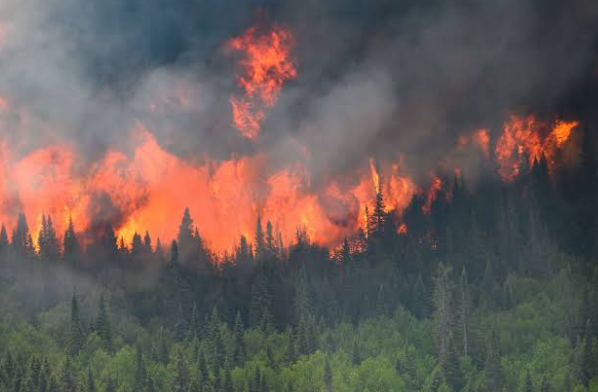

Wildfires, once considered seasonal events confined to remote forests, have now become an almost year-round global crisis, leaving not just scorched earth and destroyed communities in their wake but also an invisible killer that lingers long after the flames die down. Smoke from wildfires is emerging as one of the most dangerous yet underestimated public health threats of our time, according to the World Health Organization, which has raised alarm about the devastating consequences of breathing in toxic air filled with tiny, harmful particles. As flames sweep across forests, grasslands, and communities in various parts of the Northern Hemisphere and beyond, the pollution released into the atmosphere doesn’t just remain local; it drifts across borders and continents, exposing millions of people—many far from the actual fire zones—to severe health risks.
What makes wildfire smoke particularly dangerous is not just the immediate suffocating haze or the smell of burning wood that chokes entire cities, but the tiny, almost invisible particles it carries, known as PM2.5. These fine particles are so small that they can penetrate deep into the lungs and even enter the bloodstream, causing widespread damage to the respiratory and cardiovascular systems. Unlike dust or visible ash, these microscopic pollutants cannot always be seen, which is why experts warn that what you can’t see can still be deadly. For children, whose lungs are still developing, exposure can have lasting effects on their health and growth. Older adults, pregnant people, and individuals with preexisting conditions such as asthma, diabetes, or heart disease are also at the greatest risk, with studies showing spikes in hospital admissions and premature deaths during heavy wildfire smoke episodes.
The scale of this crisis is staggering. In regions of North America, Europe, and parts of Asia, entire populations have been forced to contend with skies turned orange, air quality indices that soar into hazardous zones, and governments issuing emergency warnings urging citizens to stay indoors. Yet, while staying indoors might provide some level of protection, the World Health Organization emphasizes that such measures are not equally effective everywhere. People living in poorly ventilated homes or overcrowded areas may still be exposed to dangerous levels of pollution, while those without access to air purifiers or sealed environments find themselves breathing in the same toxins they are trying to escape. For outdoor workers, low-income families, and displaced communities, the notion of safe shelter often remains an illusion.
The consequences of long-term exposure to wildfire smoke are just beginning to be understood. Scientists have already linked it to increased cases of chronic obstructive pulmonary disease, strokes, and heart attacks. Emerging research suggests potential impacts on pregnancy, with links to low birth weight and developmental issues in children. Mental health is also affected, as constant smoke-filled skies and displacement due to fires contribute to rising levels of stress, anxiety, and depression in communities. This paints a grim picture: wildfires are no longer just an environmental disaster, they are a profound public health emergency.
Governments and public health agencies are scrambling to find solutions. In many regions, authorities are distributing face masks, such as N95 respirators, which have been shown to significantly reduce the inhalation of harmful particles. Public health campaigns are being launched to educate people about keeping windows shut, using indoor air filters, and monitoring local air quality alerts. Yet, despite these efforts, the World Health Organization stresses that protection is not equally distributed, and vulnerable populations are being left behind. Wealthier households can afford high-quality filtration systems, while marginalized groups often suffer the brunt of the exposure. This inequality raises urgent questions about environmental justice, as the effects of climate change and pollution continue to widen the gap between those who can shield themselves and those who cannot.
Wildfire smoke does not recognize borders. Air pollution generated in one region often travels thousands of miles, affecting countries that had no fires of their own. Recent examples include smoke from Canadian wildfires blanketing parts of the United States in thick, hazardous air, as well as smoke from Siberian wildfires reaching Europe. This transboundary nature of air pollution highlights the interconnectedness of the crisis and underscores the need for international cooperation in tackling both the fires themselves and the pollution they generate. Climate change is driving much of this escalation, with hotter, drier conditions making wildfires more frequent, more intense, and longer-lasting. Experts warn that unless significant global action is taken to reduce greenhouse gas emissions and mitigate climate change, wildfire smoke will continue to pose increasing risks to public health for decades to come.
Public health officials stress the importance of awareness and preparedness. Many people still underestimate the dangers of wildfire smoke because it may not always cause immediate visible harm. Unlike flames that can be seen or evacuations that make headlines, smoke silently infiltrates homes, schools, and workplaces. Even short-term exposure can trigger asthma attacks, breathing difficulties, and other acute conditions, while repeated exposure carries cumulative risks that many people are not fully aware of. Sharing knowledge and resources has become critical, as protecting oneself also means protecting vulnerable groups and easing the burden on already stretched healthcare systems.
Simple actions can save lives. Wearing recommended masks during smoke events, using indoor air filters, monitoring local air quality levels through trusted apps and advisories, and limiting strenuous outdoor activities are key protective steps. Communities are also being urged to check on elderly neighbors, pregnant women, and families with small children, as these groups often require extra assistance in times of poor air quality. At the same time, policymakers are being called upon to strengthen infrastructure, provide affordable access to protective equipment, and invest in long-term strategies that address both wildfire prevention and public health preparedness.
The invisible danger of wildfire smoke is not a distant problem—it is already here, affecting millions today. Every year, the toll rises, with more hospitalizations, more respiratory illnesses, and more lives disrupted. The World Health Organization’s urgent call to recognize the unseen dangers of wildfire smoke is a reminder that our health is inextricably linked to the environment, and ignoring these risks could prove fatal. Understanding the risks, protecting your health, and sharing that knowledge with others are no longer optional—they are essential survival strategies in a world increasingly shaped by fire and smoke.
As the fires burn hotter and spread further, the smoke they leave behind serves as an ominous warning of the silent crisis in our air. What we cannot see is harming us, and the longer we delay meaningful action, the more we gamble with the health of present and future generations.


